The Cu Chi Tunnels experience takes you deep into Vietnam’s wartime history, offering a powerful, hands-on look at the ingenuity and resilience of those who lived and fought underground. Just 70 kilometers from Ho Chi Minh City, this vast 250-kilometer network invites visitors to crawl through tunnels, explore hidden chambers, and gain insight into Vietnam’s complex history.
Whether you’re into history, adventure, or culture, this guide will help you make the most of your visit to one of the country’s most unforgettable sites.
Contents
Arrival and Initial Orientation
Starting Your Visit: Presentations and Context
Your Cu Chi Tunnels experience typically begins with an orientation session designed to provide historical context before you explore the physical site. Upon arrival, you’ll be directed to a thatched presentation hut where your journey into the past begins.
Most visits start with a 15-20 minute documentary film that explains the tunnels’ historical significance and construction. The film, though dated in production quality, offers crucial background on how and why the tunnels were built, their strategic importance, and the daily challenges faced by those who lived within them. As you watch, you’ll begin to appreciate the scale of what you’re about to explore—a vast underground city that once housed entire communities.
After the film, guides will lead you to large-scale maps of the tunnel network, explaining how this underground labyrinth functioned as a complete ecosystem with living quarters, kitchens, meeting rooms, hospitals, and storage facilities. This orientation helps visitors understand that the tunnels weren’t merely hiding places but sophisticated military installations that played a crucial role in the Vietnamese resistance.
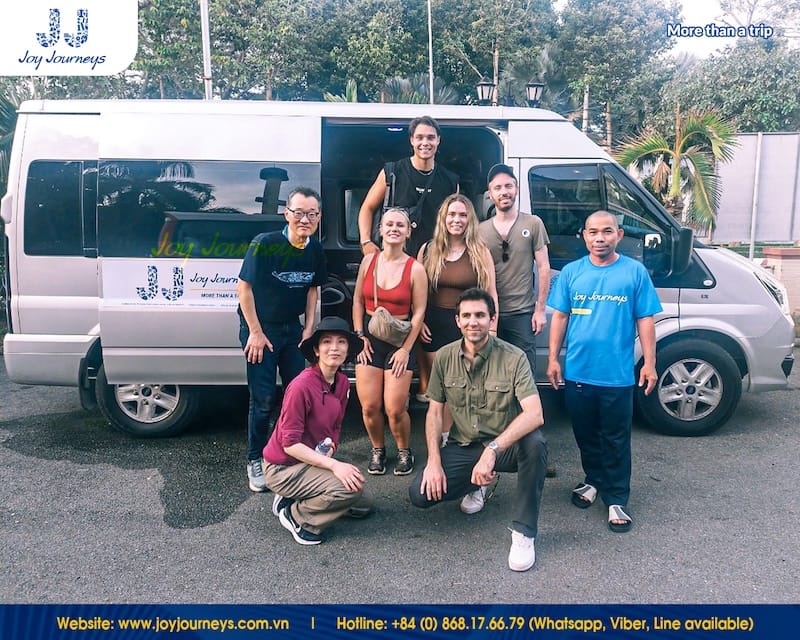
Experience of Visiting Ben Duoc vs Ben Dinh Tunnels: Comparing the Two Main Sites
The experience of visiting Ben Duoc vs Ben Dinh tunnels differs significantly, and your choice between these two main sites will shape your overall impression.
Ben Dinh Tunnels:
Located closer to Ho Chi Minh City (approximately 50 km), Ben Dinh is a more popular and accessible site. The tunnels here have been significantly enlarged and reconstructed to accommodate tourists, making them more comfortable for Western visitors. The site features:
- More developed tourist facilities and clearer signage
- Larger tunnel dimensions for easier access
- Higher visitor numbers and potentially more crowded conditions
- A convenient location next to the Saigon River (accessible by speedboat tours)
- A focus on demonstrations and interactive exhibits
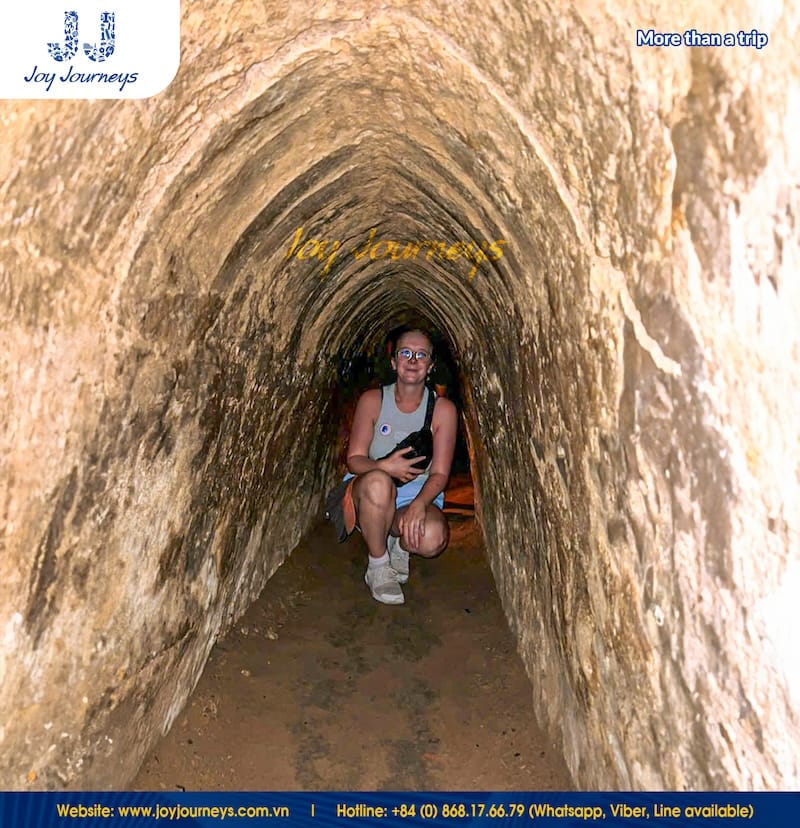
Ben Duoc Tunnels:
Located further from the city (approximately 70 km), Ben Duoc offers a more authentic and less commercialized experience. This site is approximately five times larger than Ben Dinh and features:
- A more extensive and complex tunnel network
- Fewer tourists and a more reflective atmosphere
- Narrower tunnels that, while still modified for visitors, better represent the original dimensions
- The impressive Cu Chi Tunnels Memorial Temple honoring fallen soldiers
- Demonstrations of the Hoang Cam kitchen – an ingenious smokeless cooking system
- A more peaceful setting that allows for deeper historical immersion
Exploring the Grounds: Above-Ground Exhibits
Jungle Trails and Historical Artifacts
What to expect Cu Chi Tunnels: After the initial orientation, you’ll walk along jungle paths winding through the Cu Chi complex. Shaded by bamboo and rubber trees, these trails give you a glimpse of the environment that once hid the tunnel entrances from aerial detection.
As you explore further, the landscape reveals the scars of war. Large bomb craters, some meters deep and wide, punctuate the terrain, serving as silent reminders of the intense bombing campaigns that ravaged this area. These craters are a striking testament to why underground shelters were crucial for survival.
Along the trails, you’ll also see displays of military hardware including:
- Captured or abandoned artillery pieces
- Clusters of shells and ammunition
- An ex-US Army tank that visitors can touch and photograph
- Remnants of aircraft that were shot down during the conflict
These artifacts, weathered by time but preserved as historical markers, help visitors understand the scale and intensity of the conflict that unfolded in this now-peaceful forest.
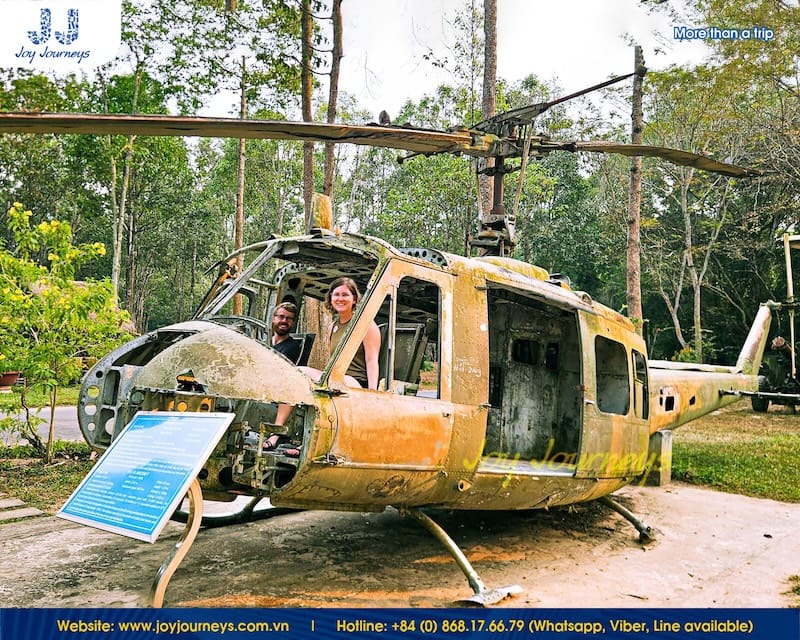
Demonstrations: Ingenuity and Danger
One of the most compelling aspects of the Cu Chi Tunnels experience is witnessing demonstrations of the ingenious defensive systems developed by Vietnamese fighters.
Booby Traps:
Guides will show you reconstructions of various traps designed to injure, immobilize, or kill enemy soldiers. These include:
- Revolving trap doors concealing pits lined with sharpened bamboo spikes
- Spring-loaded “clipping armpit” traps
- Swinging mace traps triggered by tripwires
- “Fish trap” style devices that allowed entry but prevented exit
The guides will explain how these traps were adapted over time – for instance, when Vietnamese fighters discovered that American boots protected soldiers from simple spike traps, they began coating the spikes with animal manure to cause infection.
Secret Entrances:
Perhaps the most famous aspect of the Cu Chi Tunnels experience is seeing the camouflaged tunnel entrances. Guides demonstrate how these entrances – often no larger than an A3 sheet of paper – were disguised with leaves and debris, making them nearly impossible to detect.
You’ll watch as guides demonstrate the technique for quickly entering these narrow openings and replacing the camouflaged cover from below. Many visitors are surprised by how small these entrances are – designed specifically to accommodate the smaller frames of Vietnamese fighters while excluding larger American soldiers.
The famous “photo opportunity” entrance that many visitors pose in is typically a demonstration hole that may not connect to the main tunnel system.
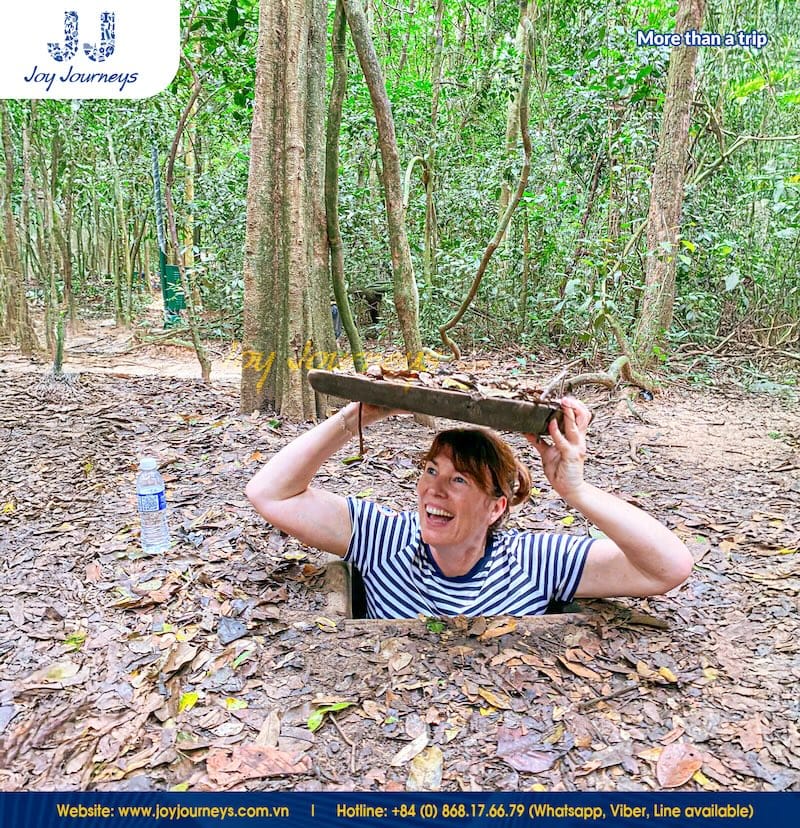
The Underground Experience: Crawling Cu Chi Tunnels
What to Expect at Cu Chi Tunnels: What It’s Really Like Inside
Crawling Cu Chi Tunnels is undoubtedly the centerpiece of any visit, offering a visceral understanding of the conditions faced by those who lived and fought underground.
The tunnels open to visitors have been modified for tourism – widened and reinforced for safety, with some sections now including electric lighting. However, they still provide an authentic sense of the confined spaces that characterized the original network.
Typical dimensions of tourist-accessible tunnels are quite tight, giving visitors a realistic feel of wartime conditions:
- Height: 1.0 to 1.2 meters – most adults will need to crouch or crawl.
- Width: 0.6 to 0.8 meters – narrow enough that your shoulders will likely brush both sides.
The Cu Chi Tunnels experience underground varies in intensity, with different sections offering varying levels of challenge:
- Shorter sections (10-20 meters): deal for those who want just a quick glimpse underground.
- Medium sections (50-70 meters): Offer a deeper, more immersive experience.
- Longer routes (100+ meters): Perfect for the adventurous, sometimes leading to lower levels for a true taste of tunnel life.
Inside the tunnels, the air becomes noticeably warmer and more humid than above ground. Limited ventilation creates a stuffy, enclosed atmosphere. Dim lighting in the tourist sections offers brief relief from the darkness, yet still reflects the disorienting nature of underground navigation. The earthen walls and floors feel cool -sometimes damp – to the touch, and the distinct scent of soil lingers throughout the experience.
Physical requirements for tunnel crawling include:
- Sufficient arm strength for lowering yourself into narrow entrances
- Comfort with confined, enclosed spaces
- Ability to crouch or crawl for extended periods
- Leaving bulky bags and personal belongings outside the tunnel area
Important health considerations: The tunnel crawling experience is not recommended for visitors with claustrophobia, respiratory conditions, heart problems, or mobility issues.

Reconstructed Underground Life
Beyond the physical challenge of navigating the tunnels, the Cu Chi Tunnels experience offers a powerful look into how these underground spaces once functioned as fully operational living environments. As you move through the network, you’ll come across reconstructions of:
- Living quarters, where fighters and civilians slept on simple wooden platforms
- Medical stations, where rudimentary surgeries were performed with limited supplies
- Command centers, where military operations were planned
- Meeting rooms, used for political education and strategic discussions
- Storage areas, stocked with food, weapons, and essential supplies
One of the most impressive demonstrations is of the Hoang Cam kitchen – an ingenious system designed to disperse cooking smoke horizontally through underground chambers and release it gradually through termite mounds far from the actual cooking site, preventing detection by American forces.
These reconstructions help visitors understand the extraordinary adaptations that allowed people to survive underground for extended periods, sometimes years, despite bombing, chemical warfare, and attempts to flood or smoke out the tunnels.
Engaging Your Senses: Sounds, Tastes, and Feelings
The Sounds of Cu Chi
The auditory dimension of the Cu Chi Tunnels experience creates a powerful sensory backdrop. Depending on when you visit, you might hear:
- The startling crack of gunfire from the nearby shooting range, creating an unexpected soundtrack that can be jarring against the otherwise peaceful forest setting
- Birds and insects in the surrounding jungle, creating a contrast between nature’s tranquility and the site’s violent history
- The hushed voices of guides and visitors echoing slightly in the tunnel chambers
- The crunch of leaves underfoot as you navigate the jungle paths
What Food Do You Eat at Cu Chi Tunnels? Tasting Wartime Rations
Most tours include the opportunity to sample the same simple fare that sustained tunnel residents during the war. The signature dish is boiled cassava (tapioca root or “Khoai Mì”) served with crushed peanuts mixed with salt and sometimes sugar.
This starchy root was a crucial food source during wartime because:
- It could be grown underground, hidden from aerial observation.
- It provided substantial calories despite its simple preparation.
- It required minimal cooking, reducing the risk of detection from smoke.
Tasting this basic sustenance offers a tangible connection to the hardships endured by tunnel residents, who sometimes survived on just this simple food for months. Many visitors are surprised by the bland yet filling nature of this wartime staple, which is typically served alongside traditional Vietnamese tea.
The Emotional Impact
Perhaps the most profound aspect of the Cu Chi Tunnels experience is its emotional resonance. Visitors frequently report a mix of feelings:
- Awe at the ingenuity and determination displayed by the tunnel builders and inhabitants
- Sobering reflection on the human cost of war on all sides
- Physical discomfort that provides just a glimpse of the hardships endured
- Deeper understanding of Vietnamese resilience and resourcefulness
To truly grasp the spirit and strength behind these tunnels, there’s no substitute for experiencing them firsthand. Step into history and see where resilience was forged underground.
Optional Activities: Beyond the Historical Core
Testing Your Aim: The Shooting Range
Is the Cu Chi Tunnels shooting range worth it? This is one of the most common questions visitors ask, and opinions vary widely. The shooting range offers the opportunity to fire authentic military weapons used during the Vietnam War, including:
- AK-47 rifles
- M16 rifles
- M60 machine guns
- Carbines and other historical firearms
Important considerations about the shooting range experience:
- Weapons are fixed in place with anchors, pointing at designated targets
- Pricing is per bullet (approximately 3 USD per round) with a minimum purchase (often 10 bullets)
- Ear protection is provided and required
- The experience is brief – firing 10 bullets takes only a few minutes
- At Ben Duoc, the shooting range is separated from the main historical area, creating less noise disruption
Most visitors agree that the shooting range is one of the most exciting activities at Cu Chi Tunnels, especially for those who have never fired such weapons before.
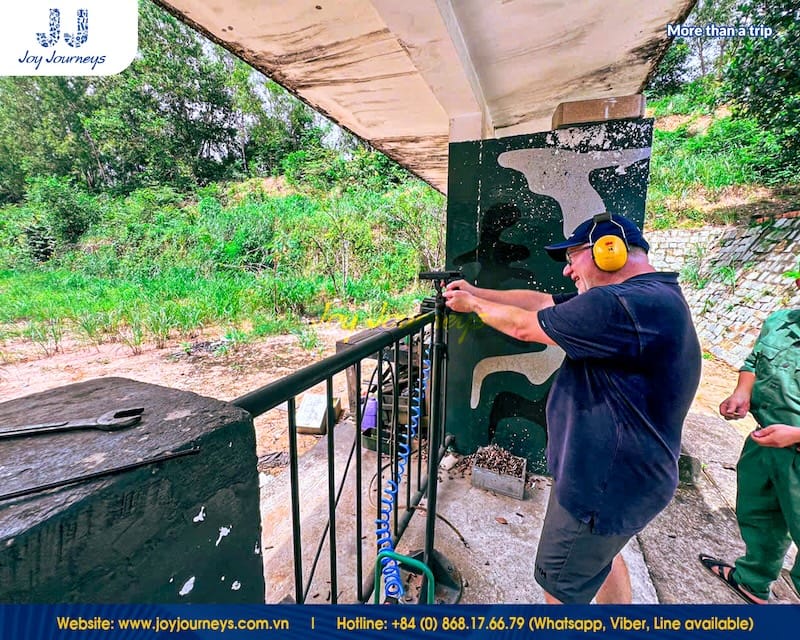
More Ways to Play: Exploring Activities at Cu Chi Tunnels
What can you do at Cu Chi Tunnels besides crawling? The site has evolved to offer numerous recreational activities beyond its historical exhibits:
Paintball:
- Team-based military simulation games in a natural forest setting
- Equipment provided includes masks, uniforms, body armor, and realistic paintball guns
- Pricing is more affordable than the real gun range (approximately 3,000 VND per round)
- Minimum purchase of one magazine (20 rounds for rifles)
- Service fee of 50,000 VND per hour covers essential equipment
Swimming Pool:
- Cu Chi park features a swimming pool built in a separate architectural style
- 500 square meters for adults and 150 square meters for children
- Facilities include dressing rooms, bathrooms, and restrooms
- Entrance fee: 20,000 VND per person
Kayaking and Pedaling:
- Relaxing activities on a lake simulating the South China Sea
- Swan-shaped boats available for pedaling
- Opportunity to explore small islands within the lake named after Vietnamese islands like “Bach Long Vi,” “Con Dao,” “Truong Sa,” and “Phu Quoc”
Zipline & Treetop Adventure Park (at Ben Duoc):
- Opened in 2022, featuring 15 treetop challenges spanning 350 meters
- 80-meter zipline soaring above the forest canopy
- 8-meter Tarzan jump for thrill-seekers
- Canopy walks and obstacle courses testing balance and agility
- Strict safety standards observed
Picnics:
- Spacious green areas with refreshing air perfect for small gatherings
- A chance to relax away from the bustling city life
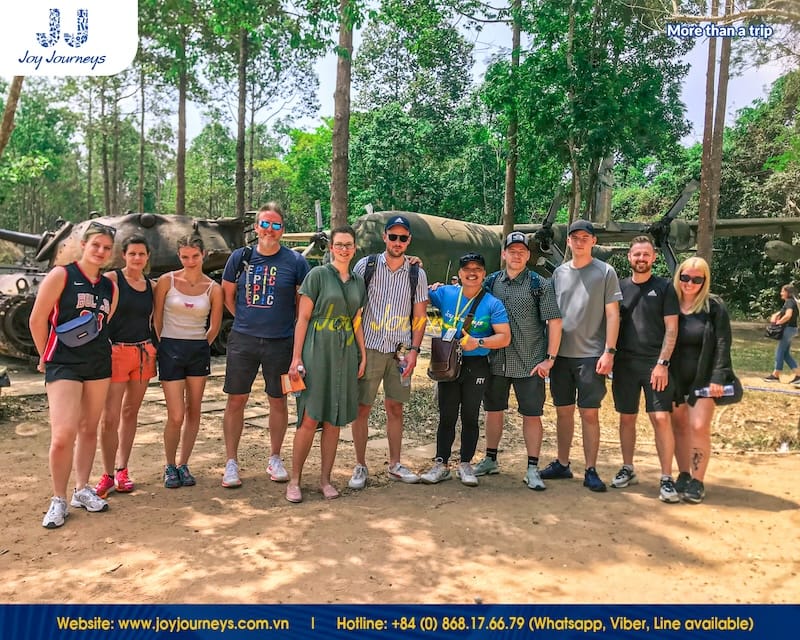
The “Warzone Moon” Night Tour (Ben Duoc)
For a unique Cu Chi Tunnels experience at night, Ben Duoc offers the “Warzone Moon” night tour, typically held on full moon nights according to the lunar calendar. The tour is available for an additional fee of 390,000 VND per person.
This immersive program recreates village life during the 1961-64 period with:
- Special lighting effects creating a moonlit atmosphere
- 3D movie presentations about the war
- Live performances depicting daily life and resistance activities
- Food tasting experiences featuring wartime rations
- Simulated sounds of aircraft and bombing
This evening program provides a different perspective on the tunnels, emphasizing the human stories and daily challenges rather than just military aspects.
Souvenir Shopping: Supporting the Community
At the end of your Cu Chi Tunnels experience, you’ll have the opportunity to purchase souvenirs that support the local community. Many items are meticulously crafted by Agent Orange victims or their descendants, providing sustainable income for affected families.
Available items include:
- Handicrafts made from bullet casings
- Traditional Vietnamese hats
- Miniature models of tunnel systems
- Books and postcards about the site’s history
- Locally produced snacks and beverages
Purchasing these items not only provides a tangible reminder of your visit but also contributes to community development and healing.
The Role of Guides and Tours
Why a Guide Enhances the Experience
While it’s possible to visit the Cu Chi Tunnels independently, the consensus among travelers is that a knowledgeable guide dramatically enhances the experience by:
- Providing crucial historical context that brings the site to life
- Sharing personal or family stories that create emotional connections
- Explaining the significance of exhibits that might otherwise be overlooked
- Ensuring safety during tunnel exploration
- Answering questions that arise throughout the visit
- Navigating the site efficiently to maximize your time
Cu Chi Tunnels Tour Highlights: Why Consider a Guided Tour?
A Cu Chi Tunnels tour handles all logistics while providing expert guidance, making it the preferred option for most visitors. Companies like Joy Journeys specialize in small-group experiences (maximum 10 guests) that focus on less-crowded sites like Ben Duoc for a more authentic experience.
Cu Chi Tunnels tour highlights include:
- Hotel pickup and drop-off from central districts
- English-speaking guides with deep historical knowledge
- Air-conditioned transportation
- All entrance fees included
- Structured itineraries that maximize your time
- Small groups ensuring personalized attention
So if you’re looking for the perfect Cu Chi Tunnels experience, why not choose a tour with Joy Journeys? Our hotline +84 (0) 868 17 66 79 is always ready to connect with you.
Conclusion
The Cu Chi Tunnels experience offers a multifaceted journey that combines historical education, physical challenge, emotional resonance, and optional recreational activities. Far more than just a tourist, the tunnels provide a window into Vietnam’s complex past and the extraordinary human capacity for adaptation and survival under the most challenging circumstances.
As you plan your trip, think about “What is it like to visit the Cu Chi Tunnels?” – A journey that goes far beyond sightseeing. Come prepared – both physically and emotionally – for an underground encounter with history that many travelers say is among the most unforgettable moments of their time in Vietnam.



Related Posts
Saigon’s “Flower Market Replica”: Where To Find Them
Ho Chi Minh City’s floral charm is not limited to its bustling wholesale markets. Imagine wandering through a place where vibrant petals, fragrant blooms, and the spirit of traditional Vietnamese markets come alive—without the overwhelming crowds. A flower market replica captures that magic, blending the beauty of fresh flowers with the charm of a curated, […]
Is it Safe to Travel to Vietnam Right Now? A Complete 2025 Guide
Vietnam has emerged as one of Southeast Asia’s most captivating destinations, drawing millions of visitors annually with its rich culture, stunning landscapes, and incredible cuisine. However, many travelers still ask: Is it safe to travel to Vietnam right now? This comprehensive guide provides you with everything you need to know about Vietnam travel safety in […]
Ho Chi Minh Cu Chi Tunnels Tour: The Ultimate Guide
The Cu Chi Tunnels stand as one of Vietnam’s most remarkable historical sites, offering visitors a profound glimpse into the ingenuity and resilience displayed during the Vietnam War. For travelers, a Ho Chi Minh Cu Chi tunnels tour represents an essential experience that combines education, adventure, and deep cultural understanding. This comprehensive guide will help […]